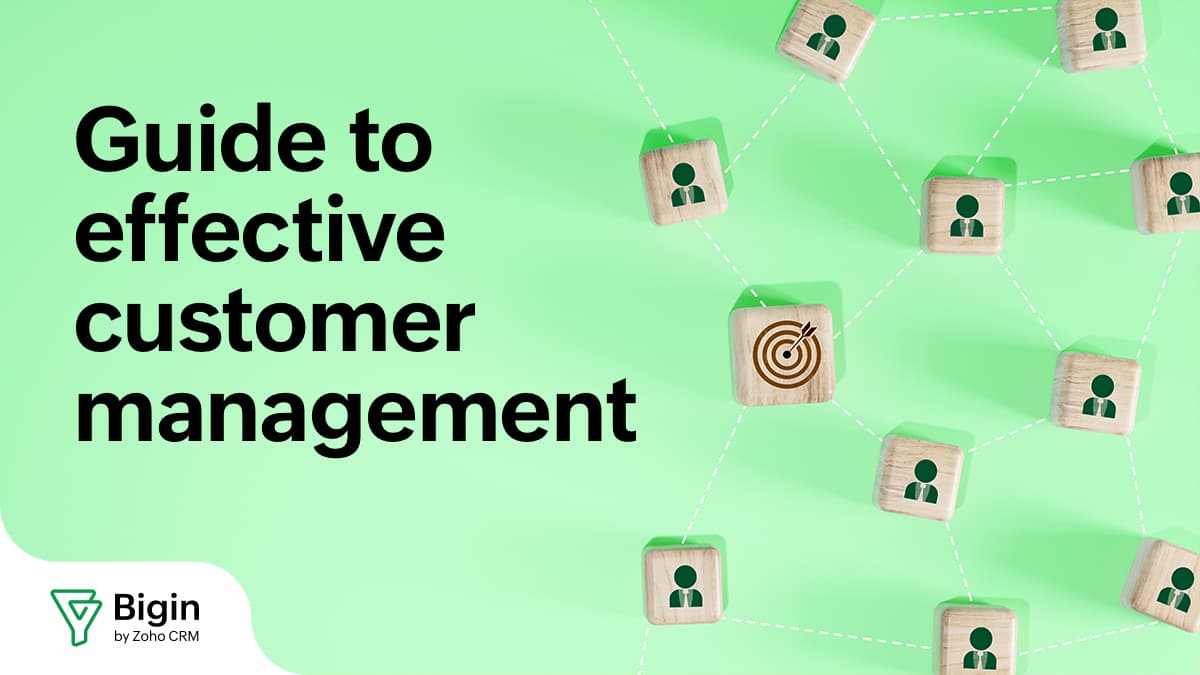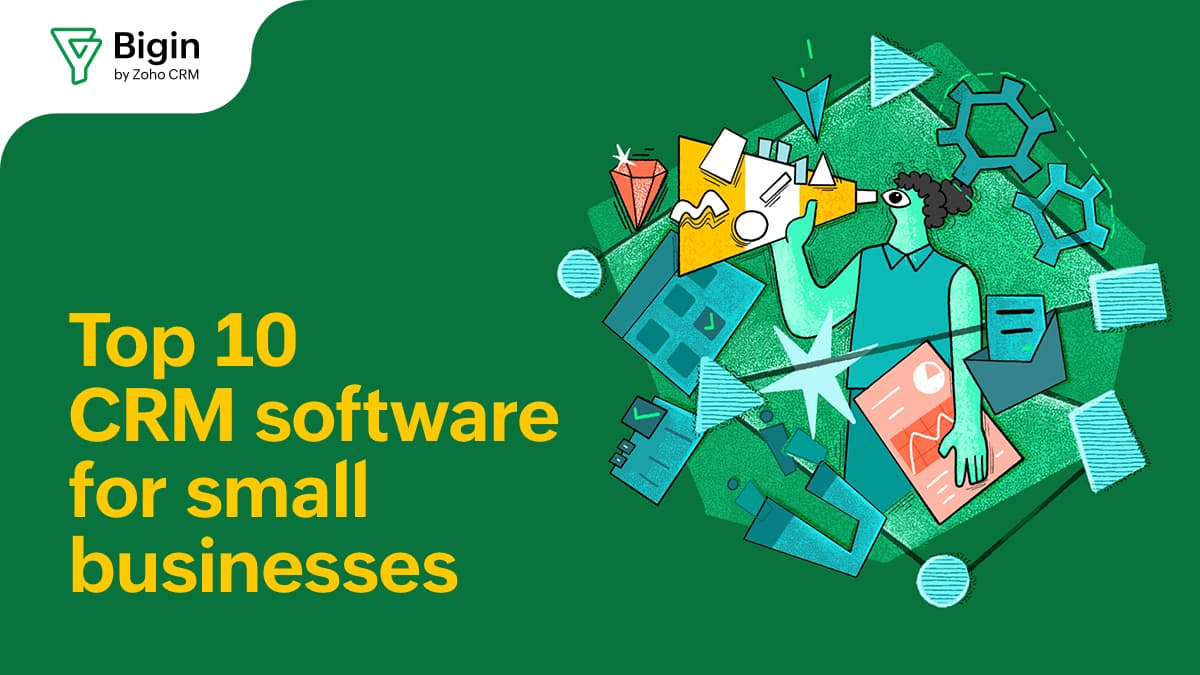Customer management: Building relationships that drive business growth
- Published : November 5, 2025
- Last Updated : November 5, 2025
- 68 Views
- 10 Min Read

Every business interaction with a customer shapes the future of that relationship. Whether you're the founder of a startup juggling multiple roles or leading a growing team, how you manage these interactions determines whether customers stay, leave, or become your biggest advocates.
Customer management is the backbone of sustainable business growth. It's about understanding who your customers are, anticipating their needs, and creating experiences that keep them coming back. The companies that excel at this build genuine relationships that create value for both sides.
In this guide, you'll discover practical strategies for managing customer relationships effectively, learn how to choose the right tools for your business, and understand why customer management deserves your focused attention.
What is customer management?
Customer management is the process of organizing, tracking, and nurturing all interactions between your business and your customers throughout their entire journey with you. It encompasses everything from the first time someone discovers your brand to their tenth purchase and beyond.
Think of it as the operational framework that helps you deliver consistent, personalized experiences at scale. You're collecting information about customer preferences, purchase histories, communication patterns, and feedback—and then using that information to make smarter decisions about how to serve them more effectively.
Its scope includes multiple touchpoints: sales conversations, support tickets, email campaigns, product usage patterns, and billing interactions. Each touchpoint generates data that helps you understand your customers more deeply. When managed well, this creates a complete picture of each customer relationship.
Modern customer management goes beyond simple record keeping; today's technology enables businesses to turn data into insights and insights into action. You can identify which customers need attention, which are ready for upsells, and which might be at risk of churning before they actually leave.
Why customer management matters more than ever
The cost of acquiring new customers continues to rise across most industries. Research consistently shows that keeping existing customers is significantly more cost-effective than finding new ones. This makes customer management a critical lever for profitability.
Your existing customers also represent your biggest growth opportunity. They already trust you enough to have made a purchase. With the right approach, they're more likely to buy again, spend more, and refer others to your business. These behaviors compound over time.
Customer expectations have evolved dramatically. People expect personalized experiences, quick responses, and seamless interactions across channels. Meeting these expectations requires coordination across your entire team, which is impossible without proper customer management practices.
The businesses that win in competitive markets are those that truly understand their customers. They know which features matter most, which pain points cause frustration, and which moments create delight. This knowledge comes from systematic customer management.
Building a customer management strategy that works
Your customer management strategy defines how you approach relationships with customers throughout their lifecycle. It's your playbook for turning one-time buyers into long-term partners.
Start by mapping out your customer journey. Identify every stage—from awareness to advocacy—and document the typical touchpoints at each stage. This helps you spot gaps where customers might fall through the cracks or opportunities where you could add more value.
Segmentation is crucial. Not all customers have the same needs, behaviors, or value to your business. Group customers by relevant characteristics like industry, company size, usage patterns, or lifecycle stage. This helps you tailor your approach rather than treating everyone identically.
Define clear goals for each segment and lifecycle stage. What does success look like when a new customer onboards? How quickly should support tickets be resolved? What percentage of customers should renew? These metrics guide your team's efforts and help you measure progress.
Your strategy should address both proactive and reactive interactions. Proactive outreach includes onboarding sequences, check-in calls, and renewal discussions. Reactive responses involve handling support requests, complaints, and inquiries. Both matter.
Assign clear ownership. Someone needs to be responsible for each customer relationship and each stage of the journey. This prevents situations where customers contact multiple team members and get inconsistent information, or where no one follows up on important issues.
Essential components of effective customer management
Customer data forms the foundation of customer management. You need a centralized place to store information about each customer: contact details, company information, purchase history, support interactions, and communication preferences. This single source of truth ensures everyone on your team works from the same information.
Communication tracking is equally important. Every email, call, meeting, and message should be logged and accessible. When anyone on your team interacts with a customer, they should be able to see the complete history instantly. This prevents awkward situations where customers have to repeat themselves.
Task and activity management keeps things moving forward. You need systems that remind team members to follow up, schedule check-ins, and ensure nothing falls through the cracks. The best customer experiences happen when your team stays one step ahead.
Reporting and analytics turn raw data into actionable insights. You should be able to answer questions like: Which customers are most engaged? Where are people getting stuck? Which segments generate the most revenue? What's our retention rate by cohort?
Integration capabilities tie everything together. Your customer management system should connect with your other tools: marketing automation, support desk, billing system, and product analytics. This creates a seamless flow of information across your entire operation.
The role of customer communication management software
Customer communication management software centralizes and streamlines how you interact with customers across all channels. It ensures that everyone on your team has access to the full conversation history, regardless of whether the customer reached out via email, chat, phone, or social media.
These software tools eliminate information silos. When your support team, sales team, and success team all work from the same platform, customers get consistent experiences. They don't have to explain their situations multiple times or deal with contradictory information from different departments.
Automation features handle repetitive tasks without sacrificing personalization. You can set up workflows that send welcome emails to new customers, assign support tickets to the right team members, or trigger alerts when high-value customers haven't logged in recently. This frees your team to focus on high-impact interactions.
The best customer communication management software adapts to your workflow rather than forcing you to adapt to it. Look for flexible systems that let you customize fields, create your own views, and build automation rules that match your specific needs.
Collaboration features are often overlooked but incredibly valuable. Your team should be able to leave internal notes on customer records, mention colleagues for input, and hand off conversations smoothly. This is especially important as your team grows.
Key features to look for in customer management tools
A clean, intuitive interface matters more than you might think. If your team finds the software confusing or clunky, they won't use it consistently. Poor adoption undermines the entire purpose of having a customer management system.
Mobile accessibility is increasingly important. Your team needs to update customer records, respond to inquiries, and access information from anywhere. This is especially true for sales teams who spend time in the field or support teams who work remotely.
Robust search and filtering capabilities help you find information quickly. You should be able to search by customer name, company, email, tag, or any custom field you've created. Advanced filters let you create segments on the fly for targeted outreach.
Customizable pipelines and workflows enable you to map the software to your actual processes. Your sales cycle, onboarding flow, and support escalation process should all be reflected in how you structure your customer management system—so keep an eye out for this.
And remember, an email integration is non-negotiable. Your team should be able to send and receive emails directly through the platform, with all messages automatically logged to the relevant customer record. This eliminates the need to copy information between systems.
Finally, reporting flexibility determines how well you can analyze your customer data. Pre-built reports are helpful for common questions, but you'll also need the ability to create custom reports that answer your specific business questions.
Implementing customer management best practices
Start with data hygiene. Establish clear rules for how information should be entered and maintained. Decide on naming conventions, required fields, and tag structures. Consistent data entry makes everything else easier and more effective.
Train your team thoroughly. Even the best software fails if people don't know how to use it properly. Invest time in comprehensive training when you first implement your system and provide ongoing education as you add new features or processes.
Document your processes. Create clear guidelines for how different situations should be handled: who responds to different types of inquiries, how quickly responses are expected, when to escalate issues, and how to log information. This ensures consistency.
Review and refine regularly. Schedule quarterly reviews of your customer management approach. What's working well? Where are customers getting frustrated? What processes feel clunky for your team? Use these insights to improve continuously.
Gather feedback from both customers and team members. Your customers can tell you where their experience falls short. Your team can identify which parts of your process or tools create unnecessary friction. Both perspectives are valuable.
Measuring customer management success
You can't improve what you don't measure. Tracking the right metrics helps you understand whether your customer management efforts are actually working and where you need to adjust your approach. The metrics below give you a complete picture of customer relationship health, from financial impact to satisfaction levels.
Customer lifetime value (CLV) shows the total revenue you can expect from a customer over the entire relationship. This metric helps you understand which segments are most valuable and how much you should invest in retention efforts.
Churn rate tells you what percentage of customers stop doing business with you over a given period. Lower churn means your customer management efforts are working. Track churn by segment to identify where you need to improve.
Net Promoter Score (NPS) measures customer satisfaction and loyalty. It's a simple question: "How likely are you to recommend us to a friend or colleague?" The responses you get help you gauge overall customer sentiment.
Customer retention rate is the opposite of churn, showing what percentage of customers stay with you over time, rather than leave. High retention rates indicate that you're delivering ongoing value and managing relationships effectively.
Response and resolution times matter, especially for support interactions. Customers expect quick responses when they have questions or problems. Track these metrics to ensure your team meets customer expectations.
Revenue expansion metrics show how well you're growing existing accounts. Are customers upgrading to higher plans? Are they buying additional products? This indicates whether you're identifying and acting on upsell opportunities.
Common customer management challenges and solutions
Information overload can paralyze your team. You're collecting so much data about customers that it becomes hard to identify what actually matters. The solution is to focus on actionable metrics and insights rather than tracking everything possible.
But even with clean data, you'll face another challenge: inconsistent customer experiences across channels. These experiences frustrate customers. Someone might get great support via email but poor service via phone. Solve this by ensuring all teams use the same customer management platform and have access to the same information.
Scaling personal touches becomes harder as you grow. What worked when you had 50 customers doesn't work with 500 or 5,000. The answer is strategic automation that handles routine tasks while freeing your team for high-value interactions.
And here's where things get tricky: Team silos create disconnected experiences. When sales, support, and success teams operate independently, customers notice. Break down silos by implementing shared goals, regular cross-team meetings, and a unified customer management system.
Outdated or incomplete customer data leads to embarrassing mistakes and missed opportunities. Combat this with regular data cleaning, validation rules that prevent bad data entry, and integrations that automatically update information.
The future of customer management
Customer management is evolving rapidly, driven by new technologies and changing customer expectations. Understanding where things are headed helps you prepare and invest in the right capabilities today. Here's what I think the next few years will bring:
Artificial intelligence is transforming how businesses manage customer relationships. AI can predict which customers are likely to churn, suggest the next best action for each customer, and even handle routine inquiries through chatbots. These capabilities will become table stakes.
Predictive analytics will shift customer management from reactive to proactive. Rather than waiting for customers to report problems, you'll identify issues before they escalate. Rather than hoping customers renew, you'll know weeks in advance which accounts need attention.
Beyond prediction, there's the experience itself. Omnichannel experiences will become seamless. Customers will start conversations on one channel and continue them on another without friction. Your customer management system will tie all these interactions together into a coherent thread.
But with greater capability comes greater responsibility. Privacy and data protection will remain critical concerns. As regulations evolve and customer awareness grows, businesses will need to be more transparent about data collection and more careful about data security. Your customer management approach must prioritize trust.
When trust is established, the possibilities are endless. Personalization will reach new levels. With better data and smarter tools, every customer interaction can be tailored to individual preferences, history, and needs. This doesn't mean creepy over-personalization, but rather relevant, helpful experiences.
Taking action on customer management
Effective customer management doesn't require perfect systems or unlimited resources. What you need is a strong commitment to treating customer relationships as valuable assets that deserve attention and investment.
Start by auditing your current approach. How do you currently track customer information? Where do things fall through the cracks? What frustrates your team about managing customer relationships? These pain points guide your improvement efforts.
Choose tools that fit your needs and budget. You don't need the most expensive customer communication management software to get started; there are many excellent options that scale with your business. Focus on finding something your team will actually use.
Build processes around your tools, not the other way around. Technology should support your customer management strategy, not define it. Start with how you want to serve customers, then find tools that enable that vision.
Invest in your team. The best customer management system is only as good as the people using it. Provide training, create clear processes, and foster a culture where everyone understands that customer relationships drive business success.
Remember that customer management is a journey, not a destination. You'll continuously learn more about your customers, refine your approach, and improve your systems. The businesses that win are those that commit to this ongoing improvement.
Your customers are the reason your business exists. Treat their data, their time, and their trust with the respect they deserve. Build systems that help you serve them better, and you'll create a foundation for sustainable growth that compounds over time.
Ready to get started?
If you're looking for a customer management solution that doesn't overwhelm your team or your budget, consider signing up for a free trial of Bigin. We built Bigin specifically for small businesses that need useful customer management features without the complexity of enterprise software.
Bigin is the perfect entry point to understand how customer management software works and whether a dedicated platform makes sense for your business. You'll quickly see how much easier it is to track relationships, follow up consistently, and grow your customer base when everything lives in one organized place.
 Anubhav
AnubhavAnubhav is a product marketer with an insatiable thirst for all things content marketing, technology, and SaaS. His expertise lies in crafting compelling narratives that resonate with audiences and drive business growth. With a deep-rooted interest in entrepreneurship, Anubhav closely follows the latest industry trends and innovations, constantly seeking new ways to elevate marketing strategies.


